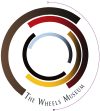By Mike Gallagher
Albuquerque Journal
Sunday July 20, 2003
When the Wheels Museum set out to raise the money to buy the Santa Fe Railway shops, board members Ron Ashcraft and John Bond suggested calling Ohio consultant Franklin Conaway.
Conaway was involved in various Ohio historical groups and had been involved in restoration projects there. Bond and Ashcraft, avowed railroad fans, had bought a restored Santa Fe Super Chief lounge car from Conaway.
Conaway’s first advice was to use another organization to borrow the $2.5 million because banks wouldn’t lend to museums.
Before forming the Wheels Museum, downtown businesswoman Leba Freed had formed the Urban Council of Albuquerque to help Downtown redevelopment.
The group decided to have the Urban Council borrow the money, which turned out to be more than a simple bank loan since neither nonprofit company could guarantee repayment.
In November 2000, a group of underwriters was formed to secure the loan from the Los Alamos National Bank. The group consisted of Ashcraft Real Estate and Development Corp., headed by Ron Ashcraft’s brothers Terry and Daniel; Waterman Inc., Ted Waterman president; TRK Management Inc., Robert and Roger Waterman; Thomas Duffy as manager of 3800-5th Street LLC; and Craddock Development Company Inc., James Craddock president.
At the end of November 2000, the Urban Council of Albuquerque paid $2.5 million for the 27-acre site. Closing and other costs added $318,000 to the total and the Urban Council was $114,000 short at closing and had to scramble to come up with the money.
At that time, the board members of the Urban Council were also members of the Wheels Museum board.
Day-to-day office management was left to Alan Clark, who worked for free.
Clark retired from city government after 30 years during which he was head of the city’s Cultural Affairs Department, oversaw city libraries and did a stint as manager of the city convention center.
It wasn’t long before Clark and Conaway were butting heads.
The issues ranged from Conaway’s failure to give the board written reports, to his hiring of engineering and planning firms without prior board approval.
Conaway said, “Everything I did was in line with my mission which was approved by the Urban Council.”
Since Wheels was raising the money that was paying Conaway and other bills, Clark insisted that Wheels had the right to a strict accounting of how money was spent.
A split also developed between board members who wanted a general Wheels museum that would include Route 66, automobile, airplane and train exhibits (Clark, Freed and Wheels board member Joe Craig) and those who wanted the site devoted to trains (including Bond and Ashcraft.)
Clark, Craig and Freed began coming out on the short end of votes until they were forced off the Urban Council board.
Later, the Urban Council entered into an agreement with Albuquerque Station LLC, headed by retired Intel executive Bill Garcia.
Garcia tried to find local investors for the project but met with little success.
Charles Reuben
Albuquerque
[RE: Ortiz Y Pino, “Conning the Rubes In River City,” Weekly Alibi May 15-21]:
I am absolutely dumbfounded that Jerry Ortiz y Pino would dedicate an entire editorial promoting the undoing of the Wheels Museum right after Tom Udall managed to secure the future of Amtrak’s Southwest Chief. I wonder if Mr. Ortiz y Pino was against the enormously successful renovation of the Old Albuquerque High School as well?
Mr. Pino is right about one thing (disregarding his sarcasm), the cavernous locomotive repair facility at the rail yards is indeed “a cathedral of industry.” It is difficult for me to drive past this building and not stare in awe at its magnificent, windowed architecture. I would imagine that standing within its confines would be much like standing within the ruins of the Parthenon. So why then does Mr. Ortiz y Pino refer to its rehabilitation as a ruse or a monumental boondoggle?
Albuquerque has so little history left to its name. Would Mr. Ortiz y Pino rather see the site leveled, and, in its place, some sort of compressed sawdust and drywall subdivision raised in its place? How about another parking garage? Tens of thousands of visitors arrive in downtown Albuquerque by Amtrak’s Southwest Chief every year and, because it is a designated service stop, wait 40 minutes for the train to be refueled. It makes perfect sense that a new Amtrak station would be built near the site of the old locomotive repair facility and that passengers could spend their idle time checking out a museum set within its confines.
Mr. Ortiz y Pino characterizes the museum as competing with the city’s avowed plans and facilities but then, aside from a nearby ice cream parlor, is there anything that a casual visitor to this city would have the time or inclination to visit during their brief stay here? Furthermore, even though the Wheels Museum will be a few blocks south of the city center, I have no doubt that us locals would delight at visiting this historic place and also be pleased to find some convenient parking downtown, for a change.
Mr. Ortiz y Pino should not be so hard on the City of Albuquerque. True, the convention center may not have been a great success but the city was right on the money when they built the aquarium, the zoo, its art museum and even the Isotopes’ new stadium. Let’s not see the railroad yards go the way of the old Alvarado Hotel and the Huning Castle. A renovated rail yards, with a Wheels Museum as its centerpiece has the potential of being Albuquerque’s crown jewel.
Sometimes it seems Albuquerque is not able to recognize its treasured landmarks until the wrecking ball has leveled it. Indeed, the Wheels Museum definitely holds the promise of the preservation of one of Albuquerque’s last, most significant landmarks.
